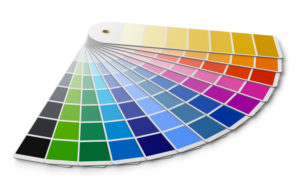Painting By The Color Wheel

Picking out paint colors can be a confusing experience, leaving you racked with indecision as you peruse swatches from paint companies. Unfortunately, they seem intent on re-creating all of the 7 million colors which are distinguishable by the human eye.
Trying to figure out which of those colors will mix harmoniously on your Reno living room wall is enough to make you turn straight to the ecru- and eggshell-white family for every interior painting project and never leave.
Complimentary Colors
A complementary color scheme is a great way to choose paint colors whether it’s for the interior or exterior of a house. This method is based on the principle that opposites attract.
You can choose two or three complementary colors by just picking the first color and then using the color wheel to find the others. These colors can always be found at opposite ends of a paint color wheel.
When you put them together, they bring out the best in each other. Both colors will look cleaner and brighter than if either was mixed with a different shade of the same hue.
The Color Wheel
A color wheel is an essential tool for paint pros everywhere. It is constructed to help you see the relationships between colors and how they work together when painting. The base colors are the three primary colors of red, blue and yellow. The primary colors are then combined together in different ways to make the three secondary colors: orange, green, and purple. Finally, the remaining six colors on the wheel are known as tertiary colors and are combinations of the secondary colors which include such hues as red-orange and blue-green.
And then, white or black is added to mute or brighten the color. So it can get very confusing when choosing paint colors! This is why familiarizing yourself with the basics of the color wheel will help you understand how to best mix and match a cool color with a warm tone. This results in a naturally balanced room.
Here are some examples of how to use these paint colors effectively. Once you have narrowed the color selection down, you might want to consult with a painting contractor about the choices you like and get their professional opinion.
Complementary Colors Yellow & Violet
If you’re somewhat nervous about suddenly splashing a couple of colors onto the walls, consider using two complementary colors as accents in the same room. In a 1950’s kitchen, a yellow window casing and violet wooden painted countertop show nicely against a neutral beadboard and white cabinets.
Complementary Colors Red & Green
Remember to figure in the finish of any woodwork in the room. In a rustic Colonial-style kitchen, a green hue brushed onto the walls and lower cabinets can complement the red tones of mahogany cabinets or flooring.
Complementary Colors Red-Orange & Blue-Green
The two colors you choose don’t have to be equally prominent in the room to work. You can use one as the main color and the other as an accent. You can also bring small colored accessories into an already painted room to see how you feel about the pair of colors you chose. An energetically bright orange-red towel or glass vase will pop against cool, blue-green walls without overwhelming the soothing and beautiful color.
Complementary Colors Orange & Blue
Keep your furniture in mind when considering new paint colors. A cool blue paint on a wall can really look good with a bright burst of orange from a pillow on your dark brown leather sofa. Little accents sometimes go a long way when using them with one wall color throughout the room.
Complementary Colors Yellow-Orange & Blue-Violet
Bright colors can breathe new life into any home and work especially well in casual living areas. For instance, glossy violet-blue pantry doors in a mudroom can pop against a yellow-orange adjacent wall. When working with more saturated hues, remember that the colors will often appear more intense on the walls than they do on the strip so be careful. Call Orange County Painting Pros for more information today!





















